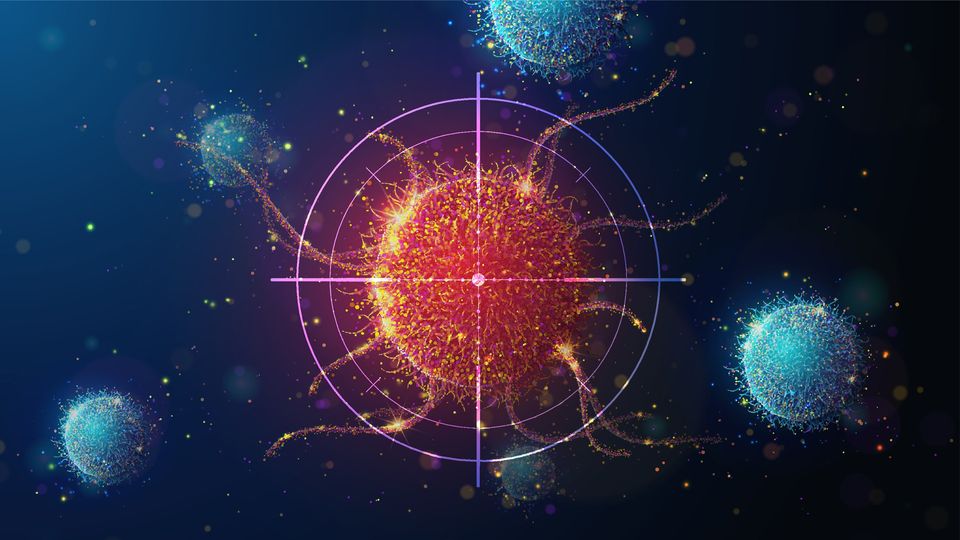Cancer Drug Discovery: Reaching for the High-Hanging Fruit
Discover how scientists are unlocking KRAS and other tough targets with AI quantum tools and next-gen antibody strategies.

Complete the form below to unlock access to ALL audio articles.
In recent decades, there’s been unprecedented progress in cancer drug discovery – from the original targeted kinase inhibitors exploiting molecular weaknesses in cancer cells, to the breakthrough of antibody-based therapeutics and checkpoint inhibitors1. Despite this progress, many of the most important mutated genes in cancer cells remained undruggable2,3. Today, there are drugs in the clinic and many more in development against these intractable targets2,3. In this article, we explore some of the latest approaches being used to target these infamous molecules.
Turning KRAS into a cell-surface antigen
About 10 years ago, Dr. Charles Craik was in the audience at UCSF when his colleague, chemical biologist Dr. Kevan Shokat, presented the progress they were making with developing inhibitors against Kirsten rat sarcoma viral oncogene homolog (KRAS). They had developed one of the first compounds that could block the common KRAS mutation, G12C – the now-approved cancer drug sotorasib.
“But the problem that occurs with all these drugs is cancers develop resistance, so we thought, let’s start thinking ahead of the game,” Craik recalled. Craik’s lab specializes in generating unique conformationally select antibodies that you can’t normally generate from a hybridoma. “We wondered, would the covalently bound KRAS-inhibitor complex show up on the surface of the cell and be detectable by an antibody?”
By combining the strengths of his and Shokat’s labs, they forged a way toward an antibody-based KRAS therapeutic that could overcome resistance and benefit a large population of patients. The first step was to prove the hypothesis that modified KRAS peptides could make it through the proteosome, be delivered onto major histocompatibility complex (MHC) alleles and be displayed on the cell surface.
They started by synthesizing two KRAS peptides each with a KRAS inhibitor covalently bound to the cysteine group and found that these peptides readily formed functional MHC class I complexes to form “haptens” that could be recognized by an antibody4.
“Once we saw this was feasible, we knew we had opened up so many possibilities,” said Craik. “Now, when resistance to KRAS inhibitors develops in a patient, we have a handle to go after.”
However, a further challenge with intracellular antigens is their density on the cell surface. “KRAS is not an abundant protein in the first place and once it’s loaded onto the MHC complexes, there’s probably fewer than 1,000 receptors per cell – and not on every cell,” said Craik.
To address this, the team is exploring targeted radio-labeled antibodies to develop a highly potent payload for antigen-bearing cancer cells. “In theory, you can target one receptor with one radionuclide, and because of the bystander effect, the drug will anchor on a single cell and hit all the surrounding tumor cells.”
An antibody carrying the beta emitter lutetium has shown the principle works in animals and now they’ve shown in animal models that actinium – an alpha emitter – might be even more effective and safe.5 “Alpha emitters are extremely potent, but the radiation only travels around five cell lengths, so they might be considered much safer than other types of radionuclides.”
Opening the door to targeting other intracellular antigens
Beyond solving resistance for patients taking KRAS inhibitors, this strategy also addresses another common issue in cancer drug discovery – the challenge of finding and targeting cancer-specific antigens versus cancer-associated antigens.
“If drugs aren’t targeting a tumor-specific antigen, we’ll always have a narrow therapeutic index between hitting the cancer cell versus the same antigens on normal cells,” said Craik. “There are actually very few truly tumor-specific antigens and most of them are intracellular, like KRAS.”
This approach opens the door to targeting other intracellular oncogenes that have previously been impossible to reach with antibody-based therapeutics. By using any irreversible inhibitor that binds to the target and stays in the tumor cells – regardless of whether it blocks its activity – it becomes feasible to label any target making it detectable on the cell surface.
Making quantum leaps in cancer drug discovery
KRAS is also the initial focus of a collaboration between Dr. Igor Stagljar and Dr. Alán Aspuru-Guzik, at the University of Toronto, and Insilico Medicine, which aims to harness the combined power of quantum computing and AI to accelerate cancer drug development. Aspuru-Guzik is developing advanced algorithms supported by quantum computing to identify prototype drugs and has already generated several compounds targeting KRAS mutations. Meanwhile, Stagljar’s lab has developed the mammalian-membrane two-hybrid (MaMTH) assay, a live cell-based platform that enables the detection of interactions between membrane-bound proteins and their partners6 and adapted this into a drug discovery platform capable of identifying small-molecule inhibitors and activators of cancer-causing mutations in a wide range of membrane proteins7.
“With MaMTH, you can monitor the interaction between wild-type and mutant KRAS and their effector proteins and assess whether candidate molecules selectively inhibit these interactions.” Stagljar’s team had built a comprehensive toolbox of KRAS mutants over many years, allowing them to rapidly test whether the compounds identified through quantum computing/artificial intelligence (AI) were specifically targeting KRAS, delivering answers within just a few weeks.
“Even with the breakthrough of the covalent inhibitors and now pan inhibitors, these compounds aren’t performing that well clinically,” said Stagljar. “We need much better and more potent clinical molecules for all the other KRAS mutants.”
The new quantum-computing/AI-enabled approach uses generative machine learning (ML) models, which can understand the underlying distribution of atoms and bonds in a dataset and then construct new molecules with predefined properties8. Although classical ML algorithms have significantly aided advances in drug discovery, combining these approaches with quantum ML algorithms can enhance target space exploration, selecting compounds out of the trillion molecules in the cloud or using generative AI to generate candidate molecules predicted to fit.
“With classical ML approaches, the positive hit rate was very low – less than 1% depending on the target,” said Stagljar. “But the power of these new algorithms has made it possible to fit molecules into cryptic pockets.” This is crucial for a challenging target like KRAS which has a very smooth surface.
Stagljar’s team tested 14 compounds identified by their hybrid quantum-classical generative model in combination with generative AI and found that two of them selectively inhibited mutant KRAS in the assay, while the others primarily affected wild-type KRAS8. “This preclinical drug discovery stage usually takes between four and six years,” said Stagljar. “But using quantum computing and AI, we’ve shortened this timeframe to about three to four months.”
Their work continues to investigate KRAS, but the team is now evolving the approach for other difficult targets such as transcription factors, ubiquitin ligases, some phosphatases and other small GTPases.
“This is where we need to collaborate because the computational tools get us the starting points, but we need to validate those small molecule hits in living cancer cells using specific functional assays, which we can do very rapidly in our lab,” said Stagljar.
“I believe this is the future of cancer drug discovery: test quickly, fail fast and move forward with the most promising candidates.”
References
1. Falzone L, Salomone S, Libra M. Evolution of cancer pharmacological treatments at the yurn of the third millennium. Front Pharmacol. 2018;9:1300. doi: 10.3389/fphar.2018.01300
2. Huang L, Guo Z, Wang F, Fu L. KRAS mutation: from undruggable to druggable in cancer. Signal Transduct Target Ther. 2021;6(1):386. doi: 10.1038/s41392-021-00780-4
3. Whitfield JR, Soucek L. MYC in cancer: from undruggable target to clinical trials. Nat Rev Drug Discov. 2025. doi: 10.1038/s41573-025-01143-2
4. Zhang Z, Rohweder PJ, Ongpipattanakul C, et al. A covalent inhibitor of KRAS(G12C) induces MHC class I presentation of haptenated peptide neoepitopes targetable by immunotherapy. Cancer Cell. 2022;40(9):1060-1069.e7. doi: 10.1016/j.ccell.2022.07.005
5. Pandey A, Rohweder PJ, Chan LM, et al. Therapeutic targeting and structural characterization of a sotorasib-modified KRAS G12C-MHC I complex demonstrate the antitumor efficacy of hapten-based strategies. Cancer Res. 2025;85(2):329-341. doi: 10.1158/0008-5472.CAN-24-2450
6. Petschnigg J, Groisman B, Kotlyar M, et al. The mammalian-membrane two-hybrid assay (MaMTH) for probing membrane-protein interactions in human cells. Nat Methods. 2014;11(5):585-592. doi: 10.1038/nmeth.2895
7. Saraon P, Snider J, Kalaidzidis Y, et al. A drug discovery platform to identify compounds that inhibit EGFR triple mutants. Nat Chem Biol. 2020;16(5):577-586. doi: 10.1038/s41589-020-0484-2
8. Ghazi Vakili M, Gorgulla C, Snider J, et al. Quantum-computing-enhanced algorithm unveils potential KRAS inhibitors. Nat Biotechnol. 2025. doi: 10.1038/s41587-024-02526-3






